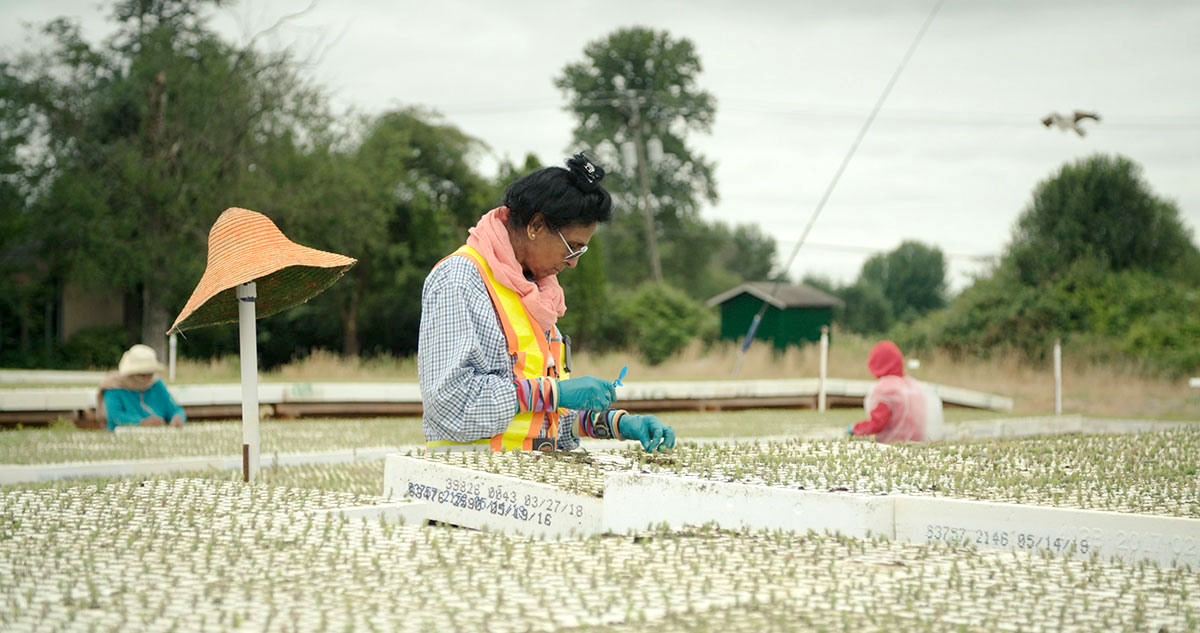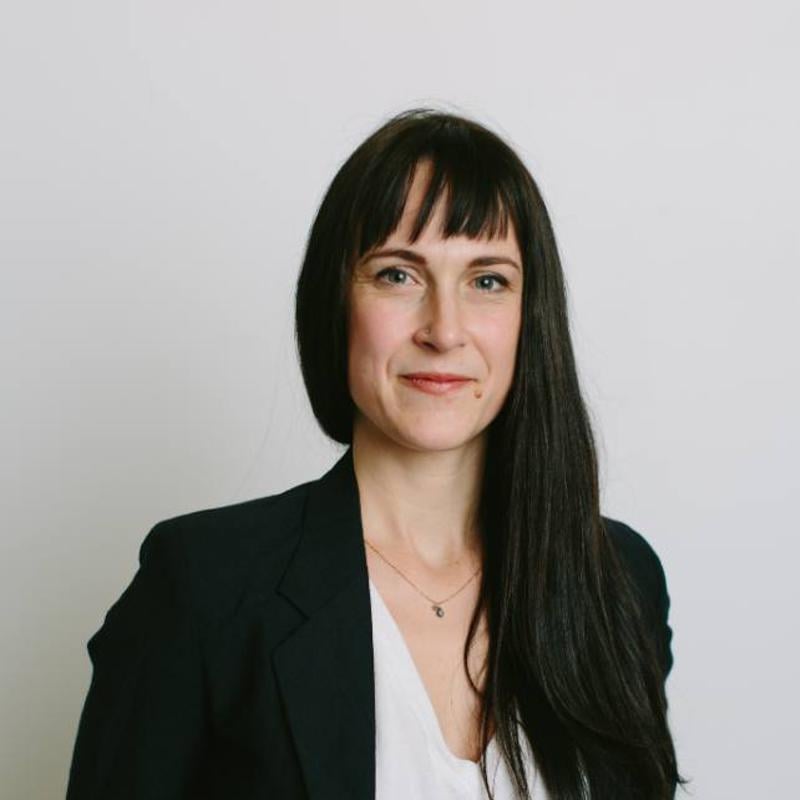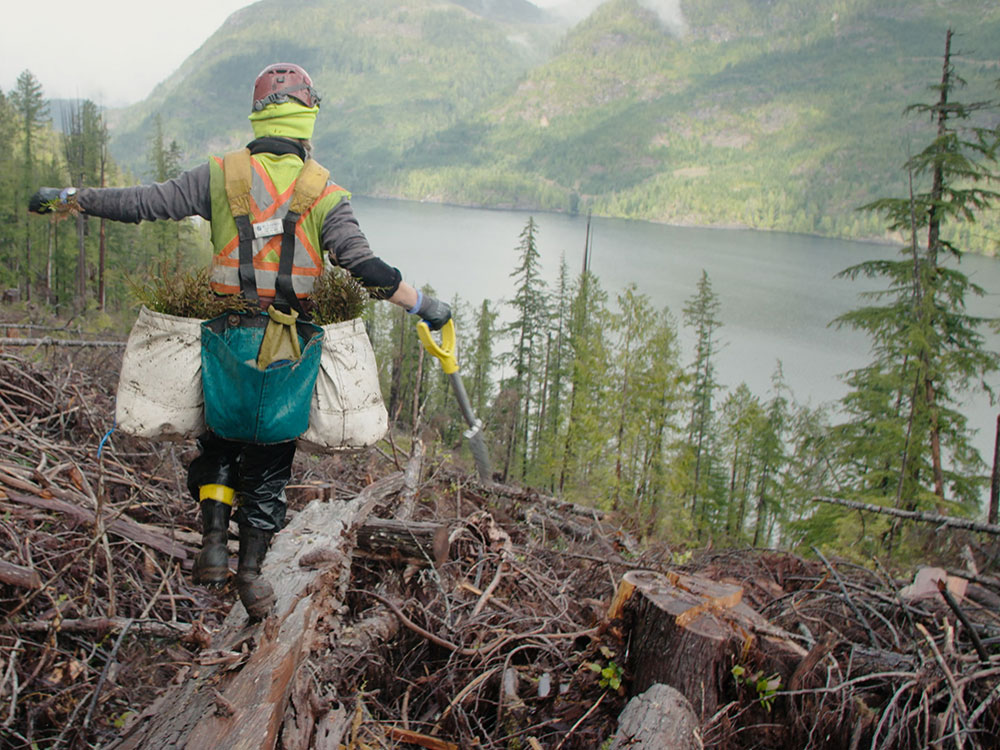The sounds of rushing wind, a far-off stream and the clink of a ball bearing inside a can of spray paint set the scene as Rob Logan climbs around the elephantine base of an old-growth cedar on Vancouver Island, his hand pressed against the tree’s bark.
He stops, pops open the canister and marks a thin white line across the middle of the tree before tracing that over with a tape measure wrapped around the trunk like a tiny lasso. He scrawls a number below the line, a sign the tree’s days are coming to an end.
Logan is a tree cruiser, and like all of the people in Silvicola, a new documentary about B.C.’s forest industry as seen by the people it employs, his story isn’t simple.
“The next person that comes in could be the guy with the chainsaw,” Logan says, a few moments later, seated atop a giant nurse log sprouting baby trees. “I just like to be out there and appreciate it for what it is before it’s all gone.”
Silvicola won the John Kastner Award at Hot Docs 2023 and the Best Canadian Feature Film at Planet in Focus 2023. This Sunday, Feb. 4, it plays at the Victoria Film Festival. Vancouver viewers can catch it at the Vancouver International Mountain Film Festival on Feb. 28. Both events offer viewing access online.
For director and producer Jean-Philippe Marquis, the film’s complex reflections are the point. “The main goal of the film is to touch into the internal dilemma,” he said. “‘I love the forest, but I destroy it.’”
Steadily and without narration, Silvicola provides a window into places often hidden from view, tracing the supply chain of B.C.’s industrial forest sector from the whirring conveyor belt of the seedling factory to the lurching bucket seat of a logging machine. It features current and former loggers, Haida and ʼNa̱mǥis foresters and knowledge holders, a timber cruiser, tree planters and mill owners, all slowly unravelling their relationships to B.C.’s forests and what has happened to them.
Gawking tourists sometimes make appearances, descending from bus tours to snap photos with big trees. “Many people want to save the forests; they know very little about it,” Marquis says. This film, he hopes, might broach a more nuanced, productive conversation between worlds.
Silvicola hits the screen at an emerging crisis point in B.C.’s forests.
Last year’s record-shattering wildfires were the most destructive in recorded history, burning millions of hectares. As decades of intensive clearcut logging have left young, monoculture forests primed to burn more, the companies that shaped the industry are fleeing to the U.S. South, liquidating jobs.
Silvicola stretches viewers’ capacity to see beauty and destruction layered in sometimes unexpected ways.
Ahead of Silvicola’s Victoria screening, The Tyee spoke with Marquis about his new film and the conversation he hopes to convene. The interview has been edited for length and clarity.
The Tyee: What inspired you to create this film?
Jean-Philippe Marquis: I started tree planting when I was 17. I spent my summer travelling from Quebec to Alberta and then to B.C. and spent over 10 summers planting. I always had the desire to document what I'd seen.
When I was planting on the West Coast it was often only boat access or by helicopter. Sometimes we stayed on barges with older forestry workers, and we’d eat dinner with the loggers and the road builders. I really enjoyed talking to them, hearing about their near-death experiences and the times they fought with bears.
I would often ask them the question: What’s the feeling of cutting a big tree? Because as a planter, I would see those huge stumps. I’d plant around them and eat my lunch on them, and I would count the rings. Sometimes I’d get to like 1,000 years. It was very powerful to work on those big stumps all the time.
So that’s what triggered the idea of the film. It wanted to get that feeling out there: What is the feeling of cutting a big tree? And from there I started to broaden it by talking to different people. I made the choice early on in the film to only feature people who work in the forest — I didn’t want to have this bad-guy, good-guy dichotomy. I wanted to make a film that would criticize some aspects of the industry, but always with respect for the workers, knowing that they love the forest, and have a deep understanding of it.
I like to say that this film was like a love letter to the forest, because I deeply love the forest and I deeply care about it.

Can you describe one of your favourite scenes?
The musical scene in the middle where you see this symphony of reforestation. We start with the people picking cones from the fallen trees and then look at how they extract the seeds. It almost puts you in a trance. I wanted to show how industrially planted forests are born.
Some people might look at the scene and say, like, “Wow, it's wonderful: check out how we plant trees on this industrial level,” and some people might say, “What a disaster, we're cutting all those forests and replacing them with farmed trees that are all the same species.” I love how people watch that scene. They have to draw their own conclusions.
What did you learn in the process of making this film?
One thing that shocked me was how few people work in the forest. I knew that the machines they use could cut many trees, I knew they were powerful, but I did not know that with, like, two trucks and a few workers you can clear cutblocks in a matter of weeks or months.
There’ll be one guy in a feller buncher, one guy in a processor, one crew boss — maybe four or five people manage an operation that changes the way the forest looks from satellites. That really blew my mind.
I was struck by some of the juxtapositions this film presents us with. We see a machine’s mechanical robot arms momentarily embrace a tree before cutting it from the stem, and then we see Haida cedar weaver Todd G̱iihlgiigaa DeVries wrap his own arms around a tree, deciding whether it’s ready to have its bark harvested. Another scene cuts from a tree planter in a massive clearcut to a small-scale cedar shingle mill. Can you talk about those juxtapositions and why you wanted to include them?
We're talking about two scales of forestry work here: a machine that will cut thousands of trees a year and a more down-to-earth, more manual way of harvesting. Once I got all the central footage for the film, I felt something was missing: some hint of a solution, and how things could be made better. So I decided to include some scenes about selective harvesting. All those forestry workers would tell me, “We need a forestry industry, but we just need less machines, and we need to do it smarter and cleaner.”
The film is non-linear, so the method I use is surprise. I like to jump back and forth between a big, loud machinery scene and a more quiet scene. I wanted to create a rhythm, and within that rhythm, I tried to tell stories: how it’s done with lots of machinery, how it could be done differently.
The industry is hemorrhaging jobs right now. What’s your response to those who might balk at a call to slow down and reduce the industry’s production?
It's very hard. Travelling for the shoot, I met workers who just lost their jobs. I travelled to Mackenzie just weeks after the mill was shut down. I’m aware that the margins are very thin, and the price of gas to bring the logs back from the cutblocks [is high]. There’s so much money in old-growth trees, and that’s why they want to keep logging them. I’m struggling myself because I want things to change, but while shooting I met many people who were on strike or had just lost their jobs, and they had a hard time feeding their families.
Some of the characters in the film are pushing for a more sustainable, slower way of doing forestry. But to change the machinery, to change the mills, those are massive investments. So if there is a transition it will be very hard, and very costly for workers and families. I’m not saying anywhere in the film we need to completely get out of the industry, because I understand how hard it is right now.
Some of your earlier documentary work looked at critical-minerals mines in the Congo, and another profiled a Palestinian farmer continuing to tend to his land within the contested border area between Israel and Palestine. In this film, we hear from folks in the Haida and ʼNa̱mǥis nations about their relationships with forests, which date back thousands of years. Can you talk about the role of land, power and colonialism in your work?
I've always been passionate about showing people where goods come from, and the impact of extraction. When I was younger, I wanted to travel the world, so I ended up in the Congo making a film about rare-mineral extraction. The film I made in Palestine was the same thing. I wanted to look at the deep, deep roots of people who have been on the land forever versus the new generations of settlers, and this industrial view that often shapes these economies.
Silvicola looks at this too. First Nations in B.C. have visions of time that go back beyond centuries. And they were managing forests for the next generation. They’d take a strip of bark or they would find one tree and decide to let it grow for 50 years before building a canoe from it. The first settler loggers saw what they thought was untouched land, but it was not — it had been managed for a thousand years before that.
Now, with culturally modified trees, we’re realizing how much of the forest was managed. What's sad is that the trees that were easily accessible to First Nations were also the most accessible to logging companies. But even now, after crazy fast-paced industrial logging, we still find thousands of them. That shows you how extensive the use of the forest was.
So there is this long-term vision and this conscience of how things used to be and how they should stay. In the industrial forestry world, it’s really, “How can we make as much money as fast as possible? How can we extract as fast as possible?” So that’s something I showed in the film, the contrast between the two thoughts, these two visions of seeing the forest.
What are you hoping this film brings to the conversation about B.C.’s forests?
I really wanted to make a film that would be enjoyed by forestry workers and environmentalists as well. I've had some workers who came to the screening say, like, “I really enjoyed that. You captured our internal dilemma.” And that was the main focus of the film: the internal dilemma of the workers. That feeling of cutting a tree, or marking a tree to be cut, but loving it, and loving being in the forest.
Keeping that in mind, I see this film as more of a base to raise interest rather than an in-depth investigation. I hope I made a film that can raise discussions and conversations about how things can be made better.
Catch 'Silvicola' on Sunday, Feb. 4, in Victoria and on Wednesday, Feb. 28, in Vancouver. ![]()
Read more: Film, Environment

















Tyee Commenting Guidelines
Comments that violate guidelines risk being deleted, and violations may result in a temporary or permanent user ban. Maintain the spirit of good conversation to stay in the discussion and be patient with moderators. Comments are reviewed regularly but not in real time.
Do:
Do not: